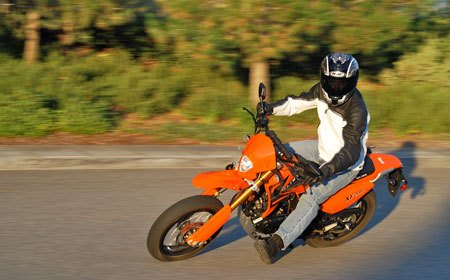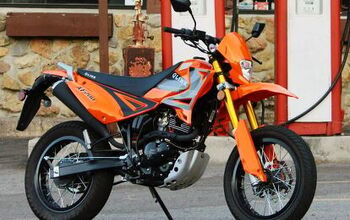2009 QLINK XF200 Review - Motorcycle.com
The next dominant force in motorcycle manufacturing appears to be taking shape. In case you’ve not noticed, China is on the move.
The idea of Chinese-made bikes buzzing around the U.S. would’ve been crazy talk only 15 years ago. Now you can’t walk into a chain auto parts store and not notice at least one two-wheeler, if not an entire section devoted to small-displacement scooters and motorcycle-like…things, all tagged with a Made in China decal.
Most motorcycles from China aren’t up to the level of quality many of us in America have come to expect from, say, Japan. But whether we want to admit it or not, the Chinese machines are getting better – or at least some are.
QLINK might not be a household name in the U.S., but the distribution company has a presence in Mexico, Brazil, Hungary, Nigeria, Taiwan, and of course China. And according to the company’s website, it has three distributions centers here: Dallas, TX, Los Angeles, CA and Edwardsville, PA. The company has a growing U.S. presence so we wanted to take a look at what they had to offer. In this instance we’ll be reviewing the XF200. To us it strikes an obvious supermoto pose though QLINK doesn’t necessarily bill it as such, rather as a dual-purpose motorcycle.
This little supermo…er, um, dualie is powered by an air-cooled, 2-valve, SOHC, 5-speed, 199cc Single feed by a Mikuni carb. QLINK claims the XF is good for 15.4 (presumably crankshaft) horsepower. The Thumper is carried in a steel-tube cradle-type frame that rolls on 17-inch aluminum Unison spoke wheels fitted with Kingstone tires: 110/70 up front and a 130/70 out back.
"To us it strikes an obvious supermoto pose though QLINK doesn’t necessarily bill it as such, rather as a dual-purpose motorcycle."
There’s a trendy, wave-type rotor up front gripped a by a single two-piston sliding-pin caliper. A drum brake slows the rear wheel. Rear suspension consists of a monoshock with adjustable spring preload by way of dual locking rings. The fork is a rather snazzy USD unit with an attractive gold finish on the legs, but unfortunately offers no adjustments.
The great pretender
Speaking of having a front end that looks up spec, if you catch just a glimpse of the XF in its orange color trim you could be forgiven for thinking it looks a little like a KTM. Indeed, the XF200 certainly looks the part, but it’s not just the fork or modern styling; the engine looks a little familiar, too.
QLINK unabashedly refers to “Suzuki technology” in the 4-stroke air-cooled engine and a “Japan Mikuni carburetor.” Using simple logic and some snooping around, we noticed an uncanny similarity to the Suzuki DR200SE. We didn’t have a little DR to scrutinize, but examining various photos reveals that about the only visible difference are the names cast into the right-side engine cover. Even the frames look remarkably alike.
Then there’s the issue of the identical bore and stroke figures (66 x 58.2mm) and a 9.4:1 compression ratio claimed by both the QLINK XF and Suzuki DR. The XF even boasts a 55.3-inch wheelbase just like the DR.
American Suzuki told Motorcycle.com that “Suzuki has no relation or connection with the QLINK XF200.” And a similar but somewhat cryptic response came from a QLINK representative when asked if QLINK was either receiving the engine directly from Suzuki or simply building it under license from Suzuki: “No. The manufacturer who made XF200 also makes engines for Suzuki in China.”
As of the publishing of this review we’re still awaiting further responses from Suzuki, but we assume the QLINK motor is built under a license agreement with Suzuki.
QLINK's business model is to source motorcycles from several manufacturers and then sell the bikes under the QLINK brand. The XF200 is manufactured by the well-established Jinan Qingqi Motorcycle Company of China. The metal plate attached to the XF bearing the bike’s VIN and the name Jinan Qingqi Motorcycle Company LTD is a dead giveaway
Furthermore, Jinan offers a model called the QM200GY-B(SD) that is clearly the same bike as the QLINK XF200, save for the Qingqi badging and different color options. With what appear to be identical mirrors, wheels, bodywork, exhaust, etc, the 199cc QLINK and Qingqi are two peas in a pod. And as a final interesting tidbit, Jinan proudly points to a relationship with Suzuki starting in 1985 as part of the Chinese company’s long bike-manufacturing history.
Regardless of who’s building the thing, if it’s built to Suzuki’s spec for the DR200SE it should have good reliability.
Japanese-level performance from China?
We didn’t have high hopes for big power from the XF, and it didn’t let us down in that respect. In a desperate tap dance for more steam, you’ll find yourself in fifth gear before you realize it, throttle pinned the whole way. Though it will rev to at least 8,500 rpm, I found short-shifting around 5K rpm kept the Single in a sweet spot. But more importantly, this shift point proved an effective method for quelling some of the vibes from the buzzy engine.
Clutchless upshifts in the 5-speed were a breeze, but sometimes the transmission was reluctant to click into neutral from second when at low rpm or at a standstill. Finally, though it didn’t appear to have an impact on function, squeezing the clutch lever resulted in a clicking sound (audible only with the engine off) behind the left side engine cover. This could be a minor issue with how the cable interfaces the release mechanism, or it could mean bigger troubles ahead.
As noted above there’s heaps of vibes coming out of the little Thumper at just about any point, but especially so around 6.5K rpm. However, it seemed to smooth out a bit near 8,000 rpm. Or maybe my hands were numb at that point in the ride. Unfortunately most of the buzz is transmitted right to the rider’s hands, though some tingling does seep into the pegs. In fairness, though, you can’t expect much less from a small-displacement one-lung.
Despite the vibey ride, I was impressed with how easily the bike started after sitting unused for days. And as an unexpected bonus there’s a kick-starter. When the bike is up to full operating temp, it only takes one easy stroke of the kicker to get the bike fired. A cold engine required a few more kicks, but only once did it need coaxing from the carb’s choke. Even your little sister could start this thing.
Slowing the 271-lb claimed dry weight supermoto isn’t what I’d call an awe-inspiring experience. Our test unit’s front brake lever had very little travel, giving me hope the powerful feel might lead to mondo stoppies. Alas, the reality is closer to the feeling experienced when attempting to squeeze two blocks of wood together.
Despite the numbness, the basic caliper slowed the bike enough to make a safe stop, though I noticed minor pulsing at the lever that led me to think the wispy rotor may have been slightly warped. The drum rear brake was more than capable of locking the wheel.
Ride quality from the budget suspension was surprisingly supple without being too mushy. There’s considerable sag when you climb aboard, but instead of exhibiting lots of chassis pitch during throttle transitions, quick cornering or excessive dive from braking, the bike remained mostly balanced with decent stability. And though the Kingstone tires don’t have the immediate name recognition of Dunlop, insufficient grip never seemed to be an issue.
Part of the XF’s appeal is its accessibility courtesy of a sensible 31-inch seat height and open, upright ergos. The saddle is wide enough for both the rider and passenger, yet narrow between the knees to allow easy flat-footing at stops. The saddle’s foam is thick yet doesn’t immediately compress like a marshmallow, remaining supportive during short jaunts.
| The Good |
| • Comfortable and unintimidating |
| • Well-tuned carb |
| • Metal 2.8 gal tank w/ locking gas cap |
| • 17-inch wheels open up tire choices |
| • Stainless-steel brake line |
| • Folding full-size off-road pegs (folding brake pedal) |
| • Electric or kick start |
| • Digital gear-position indicator. Wow! |
| • One-piece instruments with speedo and tach |
| • Bash guard/belly pan as standard |
| • LED tail light |
| • Looks like a more expensive, higher-spec bike |
| The Bad |
| • Excessive engine vibes |
| • Limited suspension adjustment |
| • Shock’s dual locking rings virtually inaccessible |
| • Rubber mounting for passenger grab handles but not for handlebar or footpegs? |
| • Poor feel from front brake |
| • Mirrors too small, view distorted by vibes and windblast folds ‘em in |
| • Brake light didn’t function when rear brake applied |
| • Not a great choice for the Interstate |
| The Ugly |
| • Headlight assembly fastened by rubber straps |
| • Cheap-looking handlebar crash pad held on by a zip tie! |
| • Rough/poor action from ignition switch; feels cheap |
| • Some decals bubbled/broken/torn |
| • Rough welds here and there on frame |
| • Small dealer network |
What’s in a name, anyway?
The air-cooled Honda CRF230M is the nearest Japanese competitor to the XF200. Factor out the Honda’s displacement advantage, and the CRF still appears the better of the two with such noteworthy items like a proper set of Dunlop tires, Showa suspension, 6-speed transmission, disc brakes front and rear, a fully fueled curb weight only 5 lbs more than the XF’s claimed dry, and of course, proven Honda reliability. But let’s not get hasty.
Sure, the XF might have some quality control shortcomings, but it's not falling apart at the seams, and generally the bike works well. But with double the factory warranty of the Honda and an MSRP of $2,299 – a 135% savings over the Honda! – the XF200 becomes a contender.
QLINK obviously doesn’t have the hard-earned good reputation of the Big Four. But neither did they when they first stormed the gates of American motorcycling. If QLINK (or any Chinese brand) will listen to ways to improve its motorcycles, the bikes’ appeal will grow, and along with it, consumers’ trust in QLINK.
I don’t have a crystal ball, but the Big Four may soon be looking over their collective shoulder, wondering how long before it becomes the Big Five, or Six, or Seven…
Related Reading
2008 Lightweight Dual-Purpose Shootout
Quarter-Liter Supermoto Shootout
More by Pete Brissette





































Comments
Join the conversation